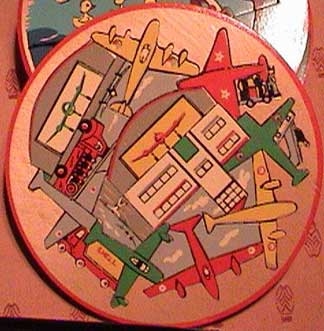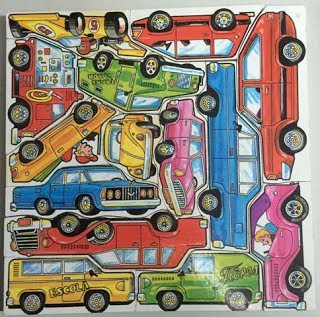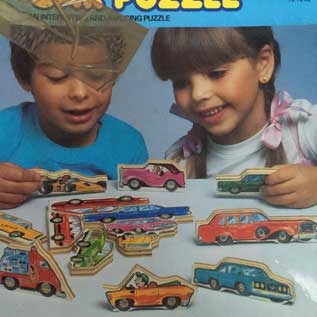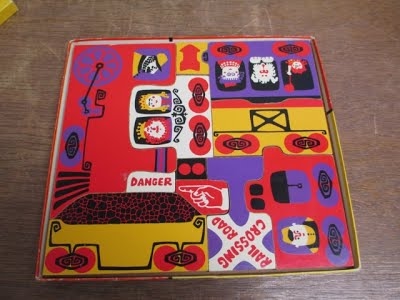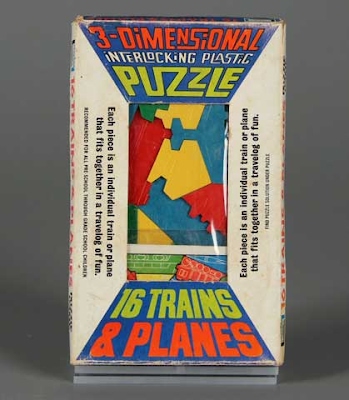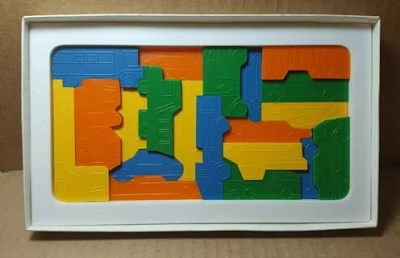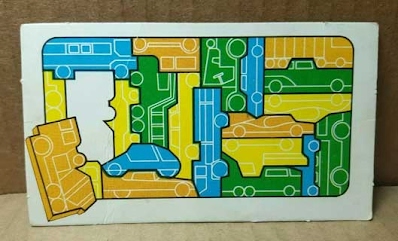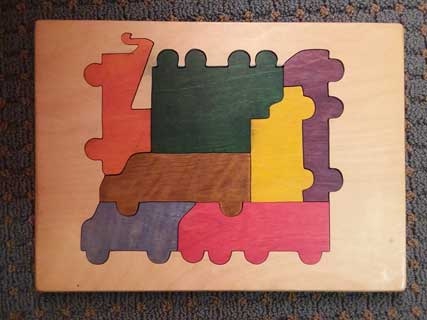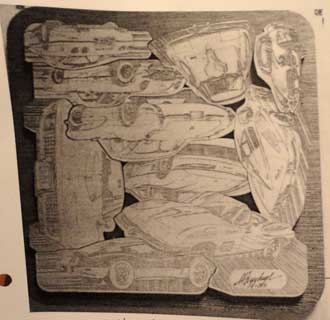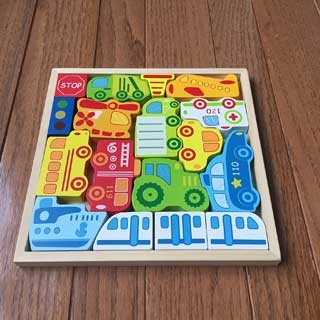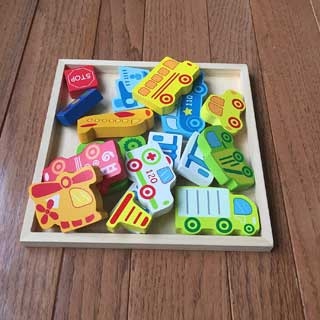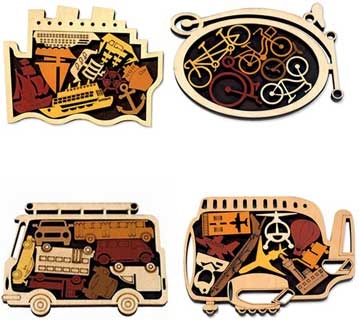Transport 1. Garage (trucks), De Haven (boats), Planes, Station (railway, trains) by Simplex, 1945–1955 2. Car Puzzle by Estrela, Cars c. 1960s, 14 pieces 3. Train Puzzle by University Craftsmen, 1967, 11 pieces 4. 16 Cars and Trucks and 20 Trains and Planes by Lakeside Toys, 1968, 16 and 20 pieces 5. 7 Trucks by Sandra Ure Griffin, 1986-1992, 7 pieces 6. Corvettes by Jim Fambrough, 1994, pieces 7. Planes, Trains and Automobiles by Portland Puzzles, c. 2016, 17 pieces 8. The Harbour, Car Park, Bike Shed, Airport by Jean Claude Constantin, 2019, 9, 8, 5, & 9 pieces Introduction Rather than essentially distinct themes without variations, such as Noah's Ark or Nativity scenes, I here show a variety of transport concepts, such as cars/automobiles, trucks, and planes, some in combination, under the catch-all title ‘Transport’. Further, some are not just of a single motif but are interrelated (such as cars and trucks) and on occasion accompanied by related aspects, such as signs. 8 distinct artists/designers with 15 distinct works are identified, albeit with qualifications as detailed below. On this occasion, the investigation is decidedly hindered by a lack of detail on the people and puzzles themselves. Indeed, of the eight artists/designers, I have only been able to detail in depth that by Sandra Ure Griffin and Simplex. All the others remain decidedly obscure, sometimes known only by a single puzzle reference. This is perhaps all the more surprising in that siz of the instances here are by companies (as against individual people), some of more substantial than others, but still next to nothing is known of them. Part of the reason here is that of the passage of time; four of the companies date from the 1945–1955 (Simplex) and 1960s (Lakeside Toys), albeit even so, I still would have expected more than a trace of them would be known. The various works are very much of a muchness in terms of quality; there are no outstanding instances, nor notably weak. A recurring feature here is the use of gaps, and so most here are of a lower tariff. However, within the lower tariff, these still have merit. Likely, the various designers were unaware of the cluster puzzle premise. Unlike other puzzles, I am bedevilled here at times by a lack of certainty as to the designer and date. Unravelling these aspects is a tiresome process, even for the ‘super enthusiast’ like myself. However, even my enthusiasm has its limits, and of which I generally do not pursue beyond an initial look; the time is judged too excessive for any likely benefit gained. Dates are, regrettably, generally not given by the designer. I have done my best, or at least of the time I want to devote to this. Corrections are welcome. 1. Garage (trucks), De Haven (boats), Planes, Station (railway, trains) by Simplex, 1945–1955 Fig. 1. (a) Garage (trucks), (b) De Haven (boats)‘Simplex’, a major Netherlands children's toy/puzzle company, of 1945–1955, has a broad four-themed transport cluster puzzles amid a seven-cluster puzzle range, although the boundaries are blurred indeed, and compounded by minor variations. These puzzles are included with reservation, considerable at times, as none of these are ideal examples of the genre, and indeed at times barely qualify. Indeed, quite what the intention of the designer is unclear. The style is at least plainly of a children’s puzzle. Indeed it is most frustrating unravelling all this under a transport theme! Of note is the circular composition, the reason of which is given in the company history below. These are titled Garage (trucks), De Haven (boats), Planes, Station (railway, trains). As can be seen, the tessellation principle is a little relaxed, as there are gaps; some of a significant nature that impinge upon the integrity of the premise. Indeed, Planes is particularly weak, and is nothing more than a push-fit puzzle. Therefore, the puzzles are of a lower tariff. Of course, Simplex may not be approaching this as according to the stricter standards of tessellation, and so such critical comments are out of place. Each puzzle has a relatively low number of pieces What is known of the company is largely due to the sterling efforts of three people: Betsy and Geert Bekkering, who wrote about them extensively in their book on Netherlands jigsaw puzzles [1], Nico Stalenburg, a Simplex enthusiast [2], and a local community website [3]. The Simplex company, at Aalst near Eindhoven of the Netherlands, under the direction of Mr F. J. van der Vlugt and a little while later Mr H. A. W. Steinmeier, from 1945-1955 produced a series of children's puzzles (as documented on Nico Stalenberg’s site). A common feature is that of a circle format, albeit with an occasional rectangle. The choice of a circle format was dictated to by the materials to hand. These are in fact made from ‘waste wood’ from the Phillips radio screens. These were then used these to make dolls furniture at first. It was an English officer who suggested making them into round jig-saw puzzles. The cluster puzzles were very much part of a small remit, and ceased after 1955, albeit the more traditional puzzles continued. Some of these included a limited range of cluster puzzles in intent. However, this is with considerable reservation, as none of these are ideal examples of the genre, and indeed at times barely qualify, and furthermore such examples were very much a small, insignificant part of a large-scale production of children’s puzzles in general. A full history is given on the dedicated page on Simplex. As ever here, does anyone know of further details of the above? No detail is too small to know. References: [1] Betsy and Geert Bekkering. Stukje Voor Stukje: Geschiedenis van de Legpuzzel in Nederland. 1988 (In Dutch) Translated: Piece by Piece: A History of the Jigsaw Puzzle in the Netherlands, 57-58 [2] Nico Stalenburg: http://www.blauwprint.nl/?page_id=42 [3] http://www.hetwaalresmuseum.nl/index.php?option=com_content&view=article&id=9&Itemid=15 2. Car Puzzle by Estrela, c. 1960s Fig. 2. (a) Puzzle, (b) Box ‘Estrela’, a major Brazilian toy company, has a single themed car puzzle (including one fire engine). It is described on the box as a ‘Car Puzzle. An Interesting and Amusing Puzzle’. The style is plainly of a children’s puzzle. It consists of 14 pieces and measures 9” x 9”. A guideline is shown with the puzzle. However, there doesn't appear to be any other documentation. The artwork is very nice. Each car is portrayed in a cartoon-like manner, of a single, bright colour, and appropriate interior detail. Pleasingly, Estrela at least intuitively understands the nature (and desirability) of themes, as evidenced by the other puzzles in this listing. As can be seen, the tessellation principle is a little relaxed, as there are gaps; however, these are relatively minor and do not largely impinge upon the integrity of the premise. However, it is indeed of a lower tariff. Of course, Estrela may not be approaching this as according to the stricter standards of tessellation, and so such critical comments are out of place. Three of the cars bear the inscriptions ‘Escola’, ‘Flores’ and ‘Trans Valor’. Quite what this signifies is unclear. A car brand? As with many other puzzles here, it has a dual purse as a puzzle and plaything; the pieces are thick enough to stand up in their own right and is shown as such on the box picture. Dating this puzzle is problematic. The puzzle is known only from a single seller on Etsy, ‘weseatree’. In this regard, he merely states ‘Vintage from the 1960s’. However, there is no documentary evidence for this on the accompanying puzzle and box pictures. Possibly, this is just a guess on his part. Of course, I enquired with him but he didn't respond. Therefore, the date here is subject to review. The above description seems to be a boilerplate advert text for Etsy sellers, who define vintage as 20+ years, and so this is not unique to this particular seller. However, for now at least, I will accept this at face value. From the graphics this does appear to be about right, although possibly a little later, of the 1970s. Any detail is at a premium. The seller merely states: Wooden Estrela Pre-SCHOOL ANIMAL PUZZLE Made in Brazil 9 x 9 inches Obviously, there is some mix up here with the description, alluding to another Estrela puzzle. Whether 'pre-school’ is of his own description or is taken from the box or other material, is unclear. Interestingly, Estrela also has another cluster puzzle of animals. However, this is of a different style and is without gaps, and so likely different designers, and also possibly chronology.
Pleasingly, much more is known as to the company. Estrela was founded in Sao Paulo, Brazil in 1937, when it started producing dolls and wooden toy cars. Its symbol is a four-pointed star, a sort of compass, referring to the company name ‘Estrela’ which means ‘star’ in Portuguese. The company has over four hundred products in their line and three factories in Brazil. Although a detailed company history is available on their website, there is no mention of any of these cluster puzzles. 3. Train Puzzle by University Craftsmen Inc., 1967 Fig. 3. (a) Puzzle, (b) Box University Craftsmen Inc. (UCI), presumably of the US, has a single themed train puzzle (including peripherals, such as signs). It is described on the box: Train Puzzle (on the rim, rather than the front!) An Educational Puzzle. Approved Design. © University Craftsmen Inc. 1967 However, much of the puzzle itself and furthermore the company remain unknown. Aside from the detail of the puzzle and box, there are, amazingly, no other references! I have searched in vain! I find the situation all most strange. The style is plainly of a children’s puzzle. It consists of 11 pieces and measures 10½" x 11½". Each individual piece measures ½" thick, and so it obviously has been designed, like many others, as a dual purpose stand-up play element. There doesn't appear to be any documentation. Each train is portrayed in a cartoon-like manner, of a single, bright colour, and appropriate interior detail. Pleasingly, UCI at least intuitively understands the nature (and desirability) of themes, as evidenced by the other puzzles in this listing. As can be seen, the tessellation principle is decidedly relaxed, as there are gaps; and furthermore considerably so, so much so that this has little artistic merit. It is indeed of a much lower tariff. Of course, UCI may not be approaching this as according to the stricter standards of tessellation, and so such critical comments are out of place. Interestingly, UCI also has two other puzzles, of animals and an alphabet, of which the box lid sappers to show all three; seemingly the box lid applies to all three. I can only surmise that despite a commercial operation, UCI must have been a cottage production that quickly went out of business. Can anyone add to the above? Does anyone know of the designer or the company? Are there any others from them? 4. 16 Trains & Planes & 20 Cars and Trucks, by Lakeside, 1969 Fig. 4a. 16 Trains & Planes Box and Puzzle Fig. 4b. 20 Cars & Trucks Puzzle and Guideline ‘Lakeside Toys’, or later ‘Lakeside’s’, of Minneapolis, US, a major US game and puzzle company of the late 1960s and 1980s, have two themed transport cluster puzzles titled 16 Trains and Planes and 20 Cars and Trucks. These are part of a six-puzzle themed series. The style (throughout all), and is stated as such, is plainly of a children’s puzzle. The puzzle is dated 1969, taken from the box. It is described on the box as: 16 Trains & Planes/20 Cars and Trucks 3-dimensional interlocking plastic puzzle Each piece is an individual plane or train that fits together in a travelog of fun. Find puzzle solution under puzzle Recommended for all pre-school through grade school children Lakeside Toys, a division of Lakeside Industries, Inc, Minneapolis, Minn. Given the two puzzles, I thus discuss each individually 16 Trains and Planes First, I am hindered in my research here in that pictures of the puzzle are at a premium, and what I have is not entirely satisfactory. However, what I do have does indeed permit a reasonably accurate assessment. As the title suggests, this is a mixture of trains and planes. 11 trains and 5 (symmetrical) planes are identified. However, the puzzle in general lacks artistic integrity; the trains are not easily discernible, whilst the planes, in plan view, are perhaps more so, but this is with the benefit of a prompt (by the title). Without the prompt, the tiles’ outlines are not particularly suggestive. 20 Cars and Trucks This is by far the better puzzle, albeit there are still quality issues here; as tiles, the cars and trucks are in general unrecognisable, but as a drawing, where this aspect is made clearer, the puzzle does at least possess a degree of respectability. Lakeside, despite being a notable producer of games and puzzles of their day, are surprisingly anonymous on the web. There is no company history as such available! That said, I do seem to recall that I saw something a while back (2016?) but this is lost. Even so, I believe it was a single reference. Whatever, they are no longer in business, apparently since the 1980s. Be that as it may, the designer’s name is not known. Likely the designer of the puzzles here also designed the others (given the same style), but who he is remains unknown. Pleasingly, the designer at least intuitively understands the nature (and desirability) of themes, as evidenced by the other puzzles in this listing. As ever, an open plea to any reader for further details on Lakeside, no matter how small for further details. 5. 7 Trucks, by Sandra Ure Griffin, 1986–1992 Fig. 5. Puzzle, 7 TrucksSandra Ure Griffin, an artist from Kansas City, US has, amid her extensive themed cluster puzzle range for the now (defunct) Pacific Puzzle Company* (PPC), of Anacortes, Washington, US a single transport cluster puzzle, simply titled 7 Trucks. Each truck (as indeed are all her puzzles) are portrayed simply, by silhouette alone, in wood, of a single painted colour. My personal preference of an optimum presentation is for interior detail to be added, but this minimalist style/presentation is still more than acceptable. The puzzle is of a relatively low number of pieces, just seven, and so the much sought-after premise of lines of a double contour of many tiles are not present by default. Indeed, only one truck is fully surrounded. Therefore, this is an easier instance to achieve, as the exterior lines do not have this concern. The trucks are mostly broadly recognisable. As a broad, simple statement, within the easier to achieve type, I find favour with these. The silhouettes are, in most cases, largely convincing, but not outstanding. This is perhaps to be recognised, as trucks lack the variety of animals, of more fluid limes, whereas manmade objects, such as trucks, lack such possibilities, and so in this sense are not so easy to achieve (or are seen).
Unfortunately, the mists of time have caused exact dates and order of the individual puzzles to be forgotten, hence the lack of chronology beyond a broad date range of 1986–1992, as related by Griffin. She also told me that the puzzles were designed independently of previous knowledge of the cluster puzzle genre, i.e. it was an independent invention. Pleasingly, unlike most of the entries here, her story can be told in full, as detailed on the generic page. In short, she can be described as a major figure in cluster puzzle history, with no less than 12 themed puzzles to her name. This was undertaken as a commercial nature, with the puzzle marketed by PPP under brothers Ian and Lee Woofenden.
* Not to be confused with a 2020 start-up jigsaw puzzle company of the same name.
Acknowledgements (in chronological order as to research); Anne Williams, for kindly drawing the PPC company to my attention. Sandra Ure Griffin, for making contact upon seeing my request for further details on Pacific Puzzle Company on the page. Ian Woofenden, for Pacific Puzzle Company background, pictures of the puzzle, brochures, and general details arising from the puzzles. Lee Woofenden, for Pacific Puzzle Company background, and general details arising from the puzzles.
6. Corvettes, by Jim Fambrough, 1994? Fig. 6. CorvettesJim Fambrough of Atlanta, Georgia, US, has a single themed transport cluster puzzle ostensibly titled Corvettes (amid one other cluster puzzle, of a likely limited commercial nature, Critterfits). However, that is about all that is known about him and the puzzle! I am hindered in my research here in that there is only one known picture of the puzzle, and it is without any documentation. Further, he is unknown on the web. Given the commercial nature of the Critterfits puzzle, it seems likely that Corvettes is in the same vein. However, if so, I have not been able to find this. All detail here is secondhand, pieced together as best I can, taken from Anne Williams, who drew this puzzle to my attention, and Etsy seller ‘YWart’, who posted Critterfits for sale in 2018. This contained vital documentation in the form of a brochure in which I have discerned his location, but nothing more. And that's it! Therefore, the text here is subject to considerable revision. The title is taken from Anne Williams’ description. The puzzle has an inscription, but the resolution does not, unfortunately, permit a clear interpretation. It may be his signature, and below this is what appears to be a series number. However, the image does indeed permit a reasonably accurate assessment as to the merits of the puzzle. The puzzle consists of ten pieces, apparently in wood, with occasional overlaps and gaps. Interestingly unlike others, the cars are portrayed more realistically, and of a variety of viewpoints. However, the silhouettes are by far from convincing; the overall impression is of cars ‘forced’ together in a contrived manner. It appears to be of ten pieces. The puzzle is not dated as such, but as Critterfits is stated by the seller on Etsy to be 1994, although not stated as such in the brochure, I thus date this as at face value as about the same date, although this vague situation in more ways than one is by far from satisfactory. Does anyone know more on Fambrough? Or indeed, can add to the story in any way. For instance, are there other puzzles?
Acknowledgements My thanks to Anne Williams for drawing this puzzle to my attention. 7. Trains, Planes & Automobiles, by Portland Puzzle Co., 2017? Fig. 7. (a) Puzzle, (b) Individual Pieces Portland Puzzle Co, of Oregon(?) US, has a single themed commercial transport cluster puzzle titled Trains, Planes & Automobiles (amid one other cluster puzzle). The title may have been based on ‘Planes, Trains and Automobiles’, a 1987 American comedy film. It is described by Portland as: Our goal is simple: to provide high quality wooden puzzles for children of all ages that help them to build, learn and grow. When children get to build and create an amazing thing happens -- their imaginations come alive and the learning process begins. As a small US-based family business we are proud to be a part of this process 17 Piece Transportation Wooden Puzzle & Play Set Our transportation themed wooden puzzle and play set is a 2 in 1 toy that can be used as a traditional jigsaw puzzle or the 3D wooden puzzle pieces can be used as individual play pieces. The 17 pieces include a train, plane, helicopter, stop sign, traffic lights, tractor, car, police car, fire truck, ambulance, school bus, delivery truck, traffic cone and ocean-liner / ship However, beyond such basics, nothing more is known of the company or the designer. It is not even clear where in the US they are based! As Portland is in Oregon, a distinct possibility is that they are based there, but this is by no means certain. The designer's name is not given; possibly the company and the designer are the same. They do not seem to have a known address; the puzzle is only available online, from a variety of distributors worldwide. It retails for £57.13 in the UK and is supplied in a tray. The style, and is stated as such, is plainly of a children’s puzzle, and with a dual play purpose, like most others here. The puzzle is not dated; however, it appears to be ‘recently’, loosely defined. I first saw this puzzle in 2017, and there is no indication that it is ‘vintage’. The 17 pieces are a respectable number. The artwork is quite nice, within the context of a children's puzzle. Each piece is portrayed simply, with one or two flat colours possessing appropriate interior detail. My personal preference of an optimum presentation is for interior detail to be added, as here. As can be seen, the tessellation principle is decidedly relaxed, as there are gaps; but not to an excessive extent in that this has little artistic merit. However, it is indeed of a much lower tariff. Of course, Portland may not be approaching this as according to the stricter standards of tessellation, and so such critical comments are out of place. Does anyone know more about Portland? Or indeed, can add to the story in any way? My thanks to Anne Williams for drawing this puzzle to my attention. ‘Seen and Noted’
In this category, for the sake of thoroughness, I include puzzles that although nominally of a transport them as above are essentially what can be described as ‘interlopers’ or of a questionably case for inclusion. Strictly, these are NOT in the spirit of the examples above, and so can be dismissed out of hand. These are only included for the sake of thoroughness, for the reader who may have seen these and perhaps thought worthy of drawing to my attention. This included a puzzle by Jean Claude Constantin. The relatively brief text generally reflects the nature of these, largely judged undeserving of too much time spent on discussing.
8. The Harbour, Bike Shed, Car Park, & Airport by Jean Claude Constantin, 2019 Fig. 8. Four Puzzles Jean Claude Constantin, a puzzle designer of Schliengen, Liel, Germany, has four commercial transport ostensibly cluster puzzles, titled The Harbour,Bike Shed, Car Park, & Airport. However, these are notably looser in comparison to most of the other puzzles here as according to the stricter tessellation principles of a double contour. Indeed, the various motifs are loosely ‘pushed together’ to form a broad ‘packing puzzle’, and so thus dilutes the tessellation principle effectively beyond such a designation. Indeed, these are described in promotional material as ‘arrangement puzzles’, which seems to imply a less rigorous puzzle. Likely, the puzzles have more than one solution, and so obviously pale in comparison to the above. Of course, Constantin may not be approaching this as according to the stricter standards of tessellation, and so such critical comments are out of place in this context. The puzzle is of wood, and coloured, with each piece a single colour, with interior detail. One nice feature here is each theme is suitably outlined within its own outline, but this is very much a subsidiary matter, and does not override the issue above. Each puzzle (on Amazon) retails for £7.99, which seems quite reasonable. The puzzles are not dated as such, but are stated on Amazon as available from 2019.
For the sake of having all aspects readily at hand to examine and assess, below I compile a ‘table of attributes’ of the puzzles above. The table includes the artist/designer, title, date, material and the number of motifs. As alluded to above, there are various ambiguities/uncertainties as to the artist/designer and dates here, and so it would be unwise to be too dogmatic here. So, bearing this caveat in mind, what can be drawn from all this? Perhaps the most obvious observation is the relative paucity of any one specific theme within the overall transport premise; cars are the most popular. The number of artists/designers is quite low, of just 6 or 7, depending on interpretation. The puzzles are a mix of old (1960s) and new (1980s+). The number of motifs is relatively low, with 20 the most (Lakeside’s Cars and Trucks). This is perhaps explained by the difficulty of tessellating with manufactured objects, typically of fixed proportions, as well as straight lines and arcs (of wheels). Although Jean Claude Constantine by far the most prolific, with four puzzles, these strictly lack tessellation principles, and are not to be compared like for like with the other puzzles. Indeed, I consider these should be separate, and ideally effectively disregarded here. Therefore, although prolificity in general is welcomed, here it is a red herring. Wood (as with other themes) is by far the preferred material; only one puzzle is of plastic Conclusion Overall, I generally find less favour, in many ways with most of the works here; most are lacking in various ways, such as a loosening of the tessellation principle, if not exceeding the bounds (Jean Claude Constantin) and very few have artistic integrity. However, there are indeed some of merit, if not of outstanding quality. In particular, I find favour with Lakeside, of the higher standards of tessellation principles as well as the Estrela puzzle, albeit this is qualified with gaps. The mooted 1960s Estrela instance is interesting historically if indeed of the period. Most, if not all of the works here are likely independent discoveries, as the designer does not refer to any preceding instances. Page Created: 10 November 2020, as 'Release 1' |
Cluster Puzzles >


